Tungsten Carbide Formed Turning Tool Introduction
- Details
- Category: Tungsten Information
- Published on Thursday, 30 October 2014 18:00
Tungsten carbide formed turning tool is a specialized tool for solid of revolution formed surface machining, and its cutting edge shape is designed according to the work piece outline. With formed turning tool, a formed surface can be processed through only one cutting stroke. It is easily operated and has high efficiency. The precision of the formed surface has nothing to do with workers’ skill, but depends on the precision of the cutting edge of turning tools. It can ensure the consistency and interchangeability of the work piece surface shape and size precision. Its processing precision can reach IT9—IT10 while the surface roughness about Ra6.3—Ra3.2. Formed turning tools can be reground for many times, thus has relatively long tool life. However, the design and manufacture of this kind tool is quite complicated and costly, and therefore, it is mainly used in the volume production of small tools and accessories.
Tungsten carbide formed turning tools can be classified into several types as follows:
I. Flat formed turning tool
This kind of turning tool is strip-shaped, which is similar to general turning tools. It is easily to be manufactured and low in cost but allows for only a few times of regrinding. It mainly applies to the machining for simple outer formed surface, such as thread turning tool.
II. Prismatic formed turning tool
The tool bit and cutter bar of this kind of turning tool are manufactured separately, which greatly increases its regrinding times along the rack face. It has rigid cutter body, but its manufacturing technology is more complicated than that of the circular formed turning tools, and it can be used only in the machining of outer formed surface.
III. Circular formed turning tool
This kind of turning tool looks like a cylinder wrapped by a prismatic formed turning tool. It allows for the most regrinding times and its manufacture is relatively easy to be conducted than prismatic formed turning tools. In addition, it can machine both the inner and outer formed surface of work pieces.

Tungsten Manufacturer & Supplier: Chinatungsten Online - http://www.chinatungsten.com
Tel.: 86 592 5129696; Fax: 86 592 5129797
Email: sales@chinatungsten.com
Tungsten & Molybdenum Information Bank: http://i.chinatungsten.com
Tungsten News & Tungsten Prices, 3G Version: http://3g.chinatungsten.com
Molybdenum News & Molybdenum Price: http://news.molybdenum.com.cn